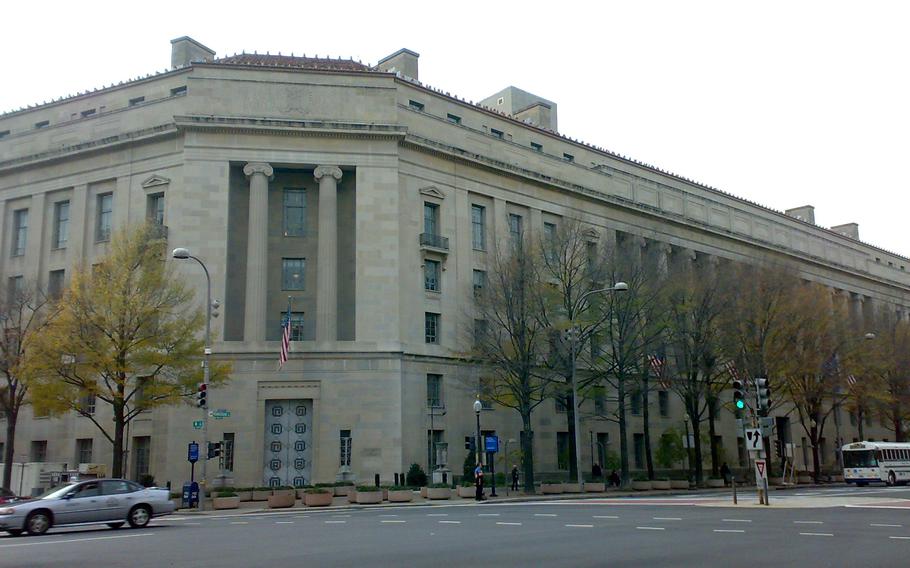
The US Department of Justice (DoJ) building, Washington, D.C. (Wikimedia Commons)
WASHINGTON — The Justice Department has updated its use-of-force policy for the first time in 18 years, telling federal agents they have a duty to intervene if they see other law enforcement officials using excessive force — a change that follows years of protests over police killings.
The new policy is outlined in a memo issued Friday by Attorney General Merrick Garland, which circulated Monday among rank-and-file federal law enforcement agents.
The Washington Post reviewed a copy of the four-page memo addressed to the heads of the FBI, the Bureau of Alcohol, Tobacco, Firearms and Explosives, the Drug Enforcement Administration, the U.S. Marshals Service and the Bureau of Prisons. Garland wrote in the memo that the guidance aims to keep the official policies of those agencies, which are arms of the Justice Department, up to date with current training and practices of federal law enforcement.
“Officers will be trained in, and must recognize and act upon, the affirmative duty to intervene to prevent or stop, as appropriate, any officer from engaging in excessive force or any other use of force that violates the Constitution, other federal laws, or Department policies on the reasonable use of force,” the memo states.
The policy, which is slated to take effect July 19, does not compel state and local police — or federal law enforcement agencies outside the Justice Department — to follow a similar standard.
The “duty to intervene” language grew out of recommendations made years ago by law enforcement groups. The change comes nearly two years after the 2020 death of George Floyd, a Minneapolis man who died under the knee of a local police officer, as other officers watched. Before Friday, the Justice Department’s use-of-force policy had not been updated since 2004.
Garland’s memo makes clear that federal law enforcement officers also have a duty to act if they see someone who needs medical care, stating: “Officers will be trained in, and must recognize and act upon, the affirmative duty to request and/or render medical aid, as appropriate, where needed.”
Larry Cosme, president of the Federal Law Enforcement Officers Association, said the policy did not arise out of any particular incident but was rather a part of a larger, longer effort to update rules and guidelines for federal law enforcement.
“It’s the modernization of policing, and you need to update policies to reflect what’s going on in our country,” Cosme said. “Every officer that’s a good officer is always going to try to do their jobs to the best of their ability, and this reinforces what the men and women in federal law enforcement are already doing.”
More broadly, the memo spells out what the Justice Department believes are best practices for law enforcement, repeating past guidance that officers should not fire their weapons at people solely because they are fleeing, nor fire into vehicles solely to make them stop.
The policy also says that deadly force should not be used “against persons whose actions are a threat solely to themselves or property unless an individual poses an imminent danger of death or serious physical injury to the officer or others in close proximity.”
The tone of Garland’s memo is also a departure from the 2004 version, which states, in simple, shorter language, that officers “may use deadly force only when necessary, that is, when the officer has a reasonable belief that the subject of such force poses an imminent danger of death or serious physical injury to the officer or to another person.”
Garland’s memo, by contrast, declares: “It is the policy of the Department of Justice to value and preserve human life. Officers may use only the force that is objectively reasonable to effectively gain control of an incident, while protecting the safety of the officer and others.”
“Officers may use force only when no reasonably effective, safe, and feasible alternative appears to exist and may use only the level of force that a reasonable officers on the scene would use under the same or similar circumstances,” the memo states.
Echoing new priorities among a great many law enforcement agencies, the Garland memo also encourages officers and agents to prioritize de-escalating confrontations, and to undergo training “in de-escalation tactics and techniques designed to gain voluntary compliance from a subject before using force, and such tactics and techniques should be employed if objectively feasible and they would not increase the danger to the officer or others.”